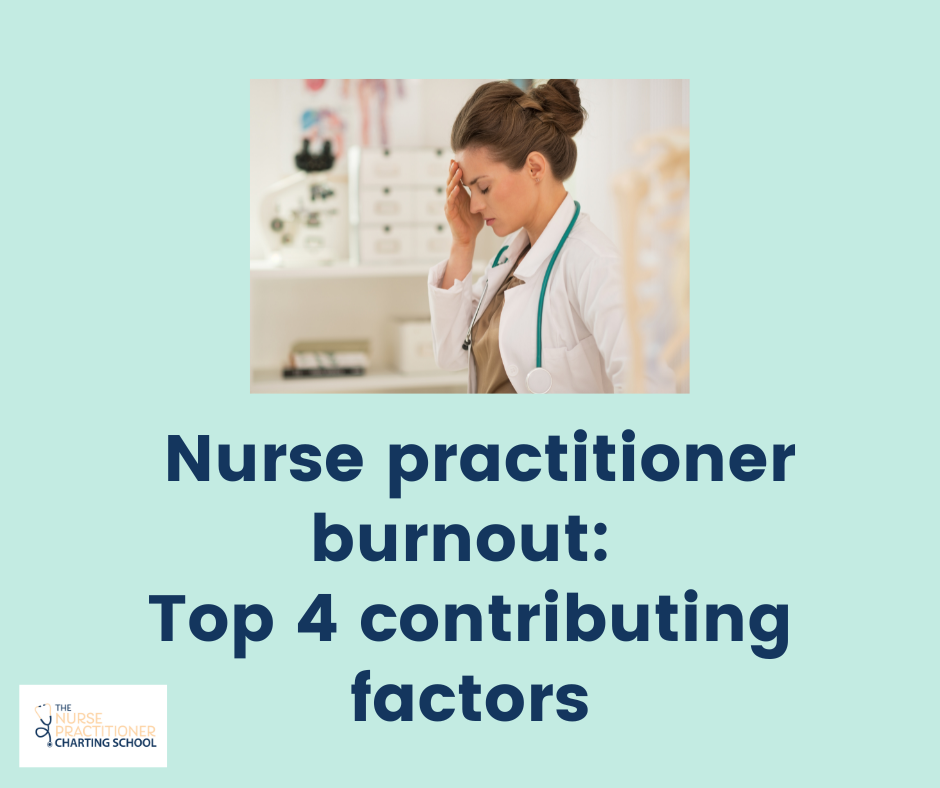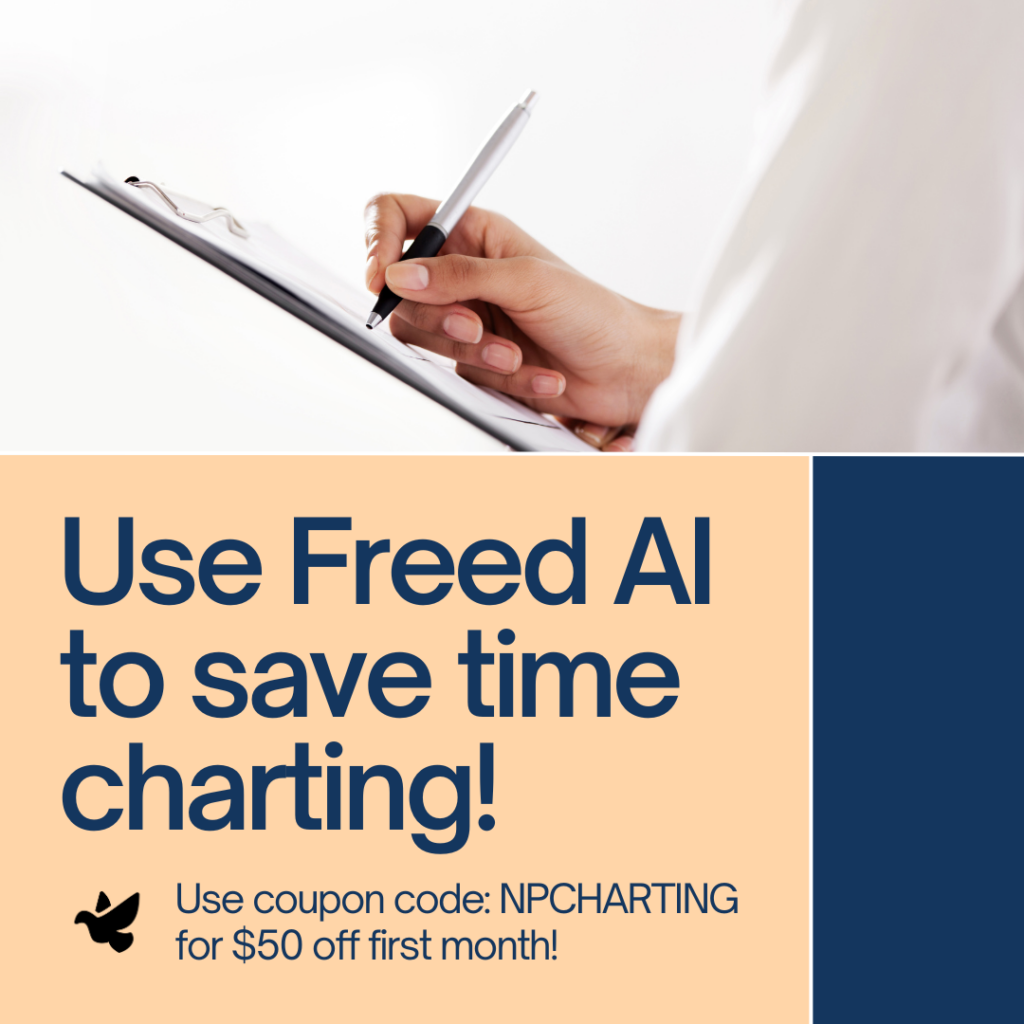I don’t think it’s news to any nurse practitioners but nurse practitioner burnout is at an all time high. There are multiple factors that contribute to nurse practitioner burnout, but there are some causes that are more challenging than others.
I originally created The Burned-out Nurse Practitioner to help overwhelmed NPs create a better work-life balance and overcome nurse practitioner burnout.
But I quickly realized the number one cause of nurse practitioner burnout was a lack of work-life balance.
And the number one cause of lack of work-life balance as a nurse practitioner is CHARTING!
So many NPs are staying late at the office or bringing charts home. So many nurse practitioners are overwhelmed by the amount of tasks to be done.
Not only do we assess, diagnose, and treat patients, but we also have to document our findings. Then add on the “other” tasks. Medication refills, reviewing past medical documents, analyzing diagnostic data, and the never ending patient messages. The work that a nurse practitioner does is never ending. Hence why so many struggle with nurse practitioner burnout.
***For more tips on charting, check out The Time Management and Charting Tips online course.
Causes of nurse practitioner burnout
Here are just a few of the contributing factors of nurse practitioner burnout. Comment below to add other causes!
The modern healthcare system.
The current healthcare system adds a lot of stress and overwhelm for nurse practitioners. There is a push to see more patients, sicker patients in a less amount of time. So many nurse practitioners are double booked with 15 minute appointments. It is difficult to see a patient for an acute complaint, let alone a chronic condition (or 2, or 3, or ……).
The modern healthcare system is doing a disservice to both patients and nurse practitioners. During a 15 minute appointment, patients do not get a full education on their medical condition and nonpharmacological treatment. And the nurse practitioner feels like a “pill mill” just prescribing medications because there is not enough time for motivational interviewing or properly educating patients.
This leaves APRNs frustrated and out of control of their patient’s care. Not to mention the electronic medical record which was supposed to make our jobs easier, is cumbersome and frustrating for many NPs. There are too many screens and buttons to click. There are too many things to chart and metrics to follow. The EHR can cause more harm than good. Nurse practitioners often spend more time documenting than they do with the actual patient. The modern healthcare system is a significant cause of nurse practitioner burnout.
Lack of education related to charting.
I don’t know about you, but I received very little training in NP school on how to properly chart. I was able to document in my clinical settings but I know many nurse practitioners that did not have this privilege.
After starting in my primary care role, I was confused with what I actually needed to chart. Afterall, charting as a nurse practitioner vs. charting as a RN is very different. If a RN is working in an acute care hospital, they are with that patient for 12 hours. The RN is responsible for documenting everything that happens in that 12 hours.
However, the role of the NP is to see the patient in the clinic/urgent care/ER or round on them in a hospital setting. An APRN’s chart note should highlight the patient’s assessment, diagnoses, and treatment. Getting through 4 chart notes in one hour vs. documenting during a 12 hour shift as a RN is very different. It takes some time to get used to charting as a NP vs. RN. These feelings of frustrations and confusion can contribute to nurse practitioner burnout.
Nurse practitioners are not thoroughly taught how to properly bill and code in NP school. I think I had a one 45 minutes class on billing and coding that barely scraped the topic. Once I began in practice, I had very little feedback on if I had the correct components in the chart note and if I was choosing the correct Evaluation and Management code.
Nurse practitioners are not properly taught billing and coding in school even though it is a very important part of our practice. The overwhelm and uncertainty can lead to nurse practitioner burnout.
***For more information on how to properly bill and code as a nurse practitioner, check out The Basics of Billing and Coding online course.
Lack of support staff.
Many healthcare facilities have struggled with staffing issues for years. But ever since the COVID-19 pandemic, nurse practitioner burnout and healthcare burnout in general have been on the rise. So many APRNs have left their roles due to nurse practitioner burnout. This can create high turnover rates in some facilities.
Not to mention other healthcare providers (RN, LPN, MAs, etc.) leaving their roles. This has created a lack of support staff in many healthcare facilities. When there is a lack of support, nurse practitioners end up taking on more tasks than what they should be doing.
Many nurse practitioners do their own referrals, respond to patient messages, and even complete prior auths. These are very time consuming tasks that could be delegated to support staff.
I have also seen an increase in nurse practitioners rooming their own patients. They spend their precious time obtaining vital signs and intake information. Some APRNs even draw labs on their patients. Interestingly enough, a lot of these nurse practitioners report their physician colleagues do not have to room patients and often work with the only RN, LPN, MA in the office. The most frustrating thing is many nurse practitioners report they see the same amount (if not more) patients as their physician colleagues.
This lack of support staff and added time it takes to complete these tasks makes nurse practitioners run behind during their work day. The work overflows to the evening hours and many nurse practitioners end up charting at home- just trying to catch up. This lack of work-life balance is a severe risk factor for nurse practitioner burnout.
Increasing health insurance regulations.
The increasing strict health insurance regulations are a cause for nurse practitioner burnout in itself! It is very frustrating to want to provide quality care and evidence based practice, but health insurance regulations make it very challenging (aka the dreaded prior auths).
As a nurse practitioner, I feel like I am at the mercy of health insurance rules. I would love to prescribe medications for patients but first have to jump through all the hoops. The patient has to try all of the cheap medications and “fail” before we can even consider a beneficial medication.
But then, I first have to complete a prior authorization in order for the insurance company to give approval of the medication. And that’s not a guarantee that they will financially cover the medication. Oftentimes, patients are stuck with paying hundreds to thousands of dollars for their medications. Sometimes they just stop taking their diabetes medications, inhalers for COPD, or other prescriptions because the cost is too high. As we know, when a patient’s medical conditions are not controlled, it can lead to complications.
I once had to fill out a prior authorization for a Type 1 diabetic to receive insulin needles. Come on….. How else is the patient supposed to administer her insulin? The amount of excessive charting and time related to prior authorizations is a significant cause of nurse practitioner burnout.
It is also frustrating to jump through the hoops of obtaining radiology scans. How many of you have seen a patient in the clinic and needed to order a CT or MRI? How many times did you send them home and say “hopefully we will hear back in 2-3 days.”
Of course we can use our clinical judgment and determine if the patient’s condition can make it 2-3 days. We have alternatives (such as sending the patient to the ED), but sometimes this is a waste of resources.
The other example is prior authing a MRI scan. So many insurance companies make patients go through 6 weeks of physical therapy treatment before approving an MRI. Now don’t get me wrong, I 110% believe in the power of physical therapy and oftentimes it can improve the patients pain/symptoms. But other times the patient does not receive any benefit (or actually has worsening symptoms) from PT treatment. They have to wait 6 weeks before we can obtain an MRI scan. Jumping through the hoops of increasing insurance regulations is a cause of nurse practitioner burnout.
Charting resources for nurse practitioners
While there are some things we cannot control as nurse practitioners (i.e. the modern healthcare system, staffing issues, insurance regulations, etc.), there are some things we can work on to improve charting and overcome nurse practitioner burnout. As The Burned-out Nurse Practitioner, I offer a Burnout Resolution for NPs online course to teach overwhelmed NPs the framework and mindset shifts to create a better work-life balance and overcome nurse practitioner burnout.
I also created The Nurse Practitioner Charting School to be the one stop for all documentation resources created specifically for nurse practitioners.
Time Management and Charting Tips Course: Learn the tips and tools to chart accurately and efficiently so you can run on time during your workday, eliminate the overwhelm, leave work on time, and STOP charting at home!
Basics of Billing and Coding Course: Feel confident choosing the correct Evaluation and Management CPT® code for an outpatient, inpatient/obs, ER, and nursing facility patient visits, so you can avoid over coding (and under coding!) ensuring you receive proper insurance reimbursement!
Legal Issues with Charting Course: Learn how to prevent a malpractice suit and put your mind at ease regarding legal issues of charting.
The Comprehensive List of Smart Phrases: Get access to over 125 smart/dot phrases!
Charting as a Nurse Practitioner Student Course: Going through nurse practitioner school is incredibly overwhelming. Don’t stress about the charting.

Erica D the NP is a family nurse practitioner and The Nurse Practitioner Charting Coach. Erica helps nurse practitioners STOP charting at home! Erica created The Nurse Practitioner Charting School to be the one stop for all documentation resources created specifically for nurse practitioners. Learn more at www.npchartingschool.com
Follow on Facebook: The Nurse Practitioner Charting SchoolAnd on Instagram: @npchartingschool
Free training: 4 charting tips to help nurse practitioners get their time back! Sign up here!




